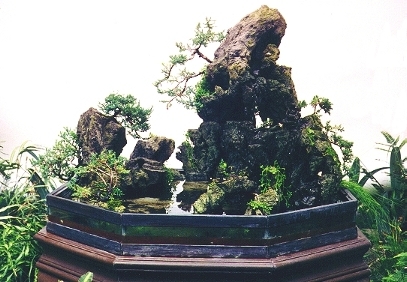Hon means "island" in Vietnamese; Non, "mountain," and Bo ,"an artful combination of water, mountain range and forest," or "copying the way the scenery (mountain, forest, ocean, animals, birds, structures, and people) looks in miniature." Hon Non Bo is a mountain landscape reduced in scale, usually set in an area of the sea close to the shore, often with full, lush vegetation. The open sea is symbolized by the water in a shallow container; it is only necessary to have the surface of the water; not a deep ocean, but merely the waves on the top. The inspiration for Hon Non Bo comes from the real world and from cultural beliefs. Making a modern day Hon Non Bo builds on and continues a long tradition of interest in and the belief of the power of rocks and the beauty of mountains and plants. Throughout Vietnamese history, Hon Non Bo have been built by emperors, kings, generals, and other important people as monuments, decorations, personal vistas, and cultural icons.
Hon Non Bo has features that make it different from other forms of living art. In bonsai, the emphasis is on the tree(s), usually one to a pot; mountains may be represented by suiseki, a separate art form, and other vegetation is represented by an accessory plant. The three elements of tree, rock, and plant suggest a natural landscape in a sparse, minimalist approach. In the past, Chinese penjing has made relatively little use of water features, while Hon Non Bo usually represent islands in a shallow sea. Rock penjing may feature interesting rocks, intricate and excellent abstract forms, but not necessarily in the shape of mountains. In Hon Non Bo, the rocks are arranged always to look like a mountain or a range of mountains. The long-term historical use of concrete containers is unique to Hon Non Bo. Bonsai and Penjing use ceramic and marble containers, with some containers occasionally made of other materials. The white of marble containers does not set off the mountain scenery of Hon Non Bo nearly so well as the dull-colored concrete containers and the size of most Hon Non Bo precludes the use of ceramic containers. It is not unusual to see concrete Hon Non Bo containers which take four persons to move. Truly skilled artisans can make concrete containers nearly indistinguishable from ceramic containers. Bonsai and penjing are usually designed to have a front, a side from which the tree or the stones look best. Hon Non Bo are designed to be seen from all sides. Bonsai are displayed so the viewer can look into the center of the tree; Hon Non Bo are displayed so the viewer can look down on the top of the display as well. The mountain must look good not just from four sides but also from the top. Bonsai is half design and half horticulture; Hon Non Bo requires the artist to be a sculptor to shape the mountain as well as be a designer and a grower. Trimming and training trees for a Hon Non Bo is similar to that for bonsai, except the style may be quite different. For some Hon Non Bo, traditional bonsai styles are appropriate, even bonsai so carefully designed and shaped they appear to be pieces of sculpture. For other Hon Non Bo, the tree's style should be much less sculpted and instead be more natural, even having somewhat of a wild appearance.
Hon Non Bo, then, generally represent a complete mountain scene, often an island mountain scene, in a shallow concrete container with water to represent the sea. Tieu canh are mini scenes. The Vietnamese people also enjoy mini scenes and miniature plants, both of which have a close relationship to miniature landscapes. The difference between a mini scene and a miniature landscape is that in a mini scene, the trees must be higher and bigger than the rock which functions as the background for the trees. The rock may appear to be farther off in the distance because it is smaller than the tree. A mini scene is part of a more complete landscape. For instance, a steep cliff, a cave, a beach, a bank of the river or stream or a lake, and so on are subjects of mini scenes. The tree in a mini scene is usually in a bending, inclining or growing-down position. Trees have to be "old, weather-beaten and faint." The styles of both Hon Non Bo and Tieu Canh continue to evolve. Like other art forms, new ideas and change are incorporated into modern Vietnamese miniature landscapes. All rights reserved. Photos copyright © Lew Buller, Mai Dinh or Lit Phan. Text by Lew Buller. Web design & photo editing by P. Seiley. |



